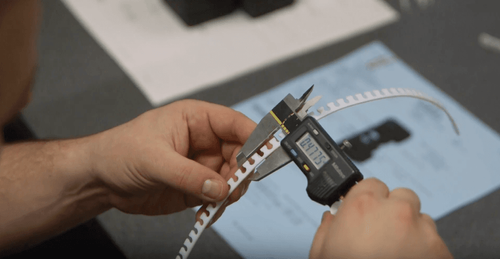
Mind The Tolerance: The Less Obvious Way To Save Time and Money on Custom Gaskets
This is where you determine tolerance range of your custom-cut flexible part, because no one wants to waste time sorting out ill-fitting pieces that won’t work. By defining the tolerance of your custom-cut flexible material, you’re establishing how much the cut can stray from the base measurement – without affecting fit and performance.
The problem with defaulting to the tightest tolerance
At the design stage, it’s common for an engineer to indicate the tightest and narrowest tolerance range the material is capable of. They might make that call based on technical data provided by the material manufacturer. Occasionally, design-aided software inserts the tightest range by default.
Choosing the tightest range can seem like the best route to a high-quality product with the best performance. After all, you want to look good to your team. But not all projects require the top-level precision. There are countless times when you can go with a wider tolerance range, and there will be no effect on quality and performance of the gasket. It’s better to find the range that meets the needs of the conditions and application.
Bottom line, it’s not always critical to use the tightest tolerance. Defaulting to the narrowest tolerance without considering other options can raise costs and delay delivery.
Outcomes from using too-tight tolerance ranges:
- Additional inspections during production, which can lead to stoppages.
- Higher scrap rate of finished products that fall outside the tight range.
- Higher material costs to make up for the scrapped products.
- More frequent changeovers and stoppages for things like inspections, tooling adjustments, and the addition of material to make parts.
Now that you know that defaulting to the narrowest possible tolerance range can add unnecessary costs to your finished product, it’s well worth the time to identify the best range for the project.
When you have an opportunity to spend less and get something faster, why not take advantage and show the team how you did so?
Expertise you can trust
At SRP, we often recognize situations where the project manager or engineer identified a too-tight tolerance range. When we do, we’ll call it to our customer’s attention, and advise them to take a second look at calculating the best range for the material and application.
Custom projects call for a custom cut and a custom tolerance range. Taking the extra step to calculate a tolerance range that’s suitable for the project will make a big impact on costs and timeline. In a time when supply chain issues are delaying deliveries and increasing costs, taking this extra step can keep your costs in line.
SRP is a proud member of the 3M Preferred Converter network. Being a Preferred Converter means we get priority access to the best materials in the industry at the best pricing, backed with technical expertise to help you identify the best material for the project.
Learn more about our custom gasket and converter capabilities. Contact SRP and request a quote.
